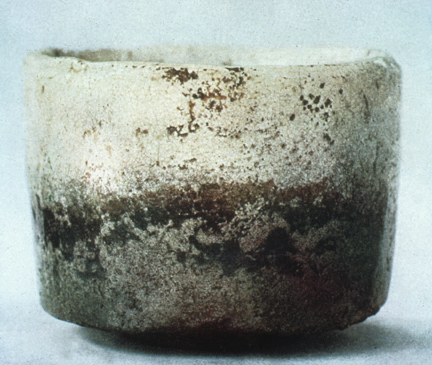Another famous tea ceremony ware, RAKU, originated during the Momoyama Period in Kyoto. Around 1574, Chojiro was the first to develop this unusual firing process. Raku is earthenware, soft and freely modeled, and perhaps best embodies the concept of wabi in Japanese ceramics. At least three of his descendants were also named Chojiro, all of whom made Raku ware. This family was awarded the Raku name by the emperor, and it has been handed down for at least 14 generations. Originally, raku was simply a quick firing process in which glazed tubules, roof tile, or other small items, were place into a kiln that was already hot. The lid or door of the kiln was then closed, and the kiln would gain temperature and the glazes would reach a stage of melting within 30 minutes. When judged by the eye to be ready, the ware is retrieved from the kiln using long tongs and heavy gloves to protect the potter's hands, and allowed to air cool to ambient temperature in just a few minutes. The entire process of firing might take 30-40 minutes per firing, rather than the week long process used in an anagama (tunnel kiln). The big advantage of the method would be to increase the number of firings one could accomplish in a given period of time, and increase productivity. The big disadvantage is that the process is brutal on the pottery, and much work is destroyed through blow ups and/or cracking due to thermal shock.
This particular raku teabowl is by Koetsu and is registered as an important cultural property. It is affectionately named 'Mount Fuji,' for its illusion of snow falling over the mountain in the way the glaze flowed and melted. Hon'ami Koetsu studied under the Raku family, and came to be considered a master in his own right.
Even though Raku ware was supposed to only be made by descendants of the original family, it came to be extensively copied in neighboring wakigama (outside kilns), and the technique would eventually spread to many workshops. The 20th century English potter and author, Bernard Leach, recalls his introduction to the seductions of Raku at a dinner party in the Japan of the 1920's, in his A Potter's Book. In the 1960's the California potter, Paul Soldner, then at Otis Art Institute, began experimenting with technique. Showing a typical American impulse to follow his own devices rather than adhering to the protocols of the original firing method, he experimented with 'post firing reduction.' He would fire using the tradition quick fire method, but upon removal from the kiln, he would place the hot piece of pottery into a metal trash can filled with a combustible, like paper or dried leaves. The hot piece would cause the paper to catch on fire, after which the lid of the can would be clamped on. The fire would go out, and a large amount of smoke is generated, which impregnates the clay body and turns it gray to black. The entire process is full of unexpected and wonderful glaze accidents, and is still used by many potters, especially borderline pyromaniacs.

Raku Teabowl by Hon'ami Koetsu, called 'Mount Fuji,'
Japan, Momoyama Period, early 1600's CE


